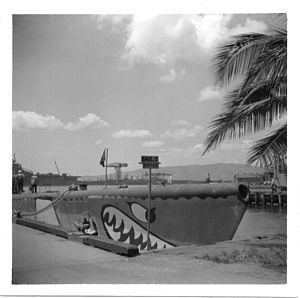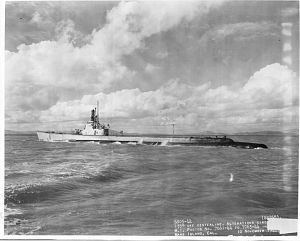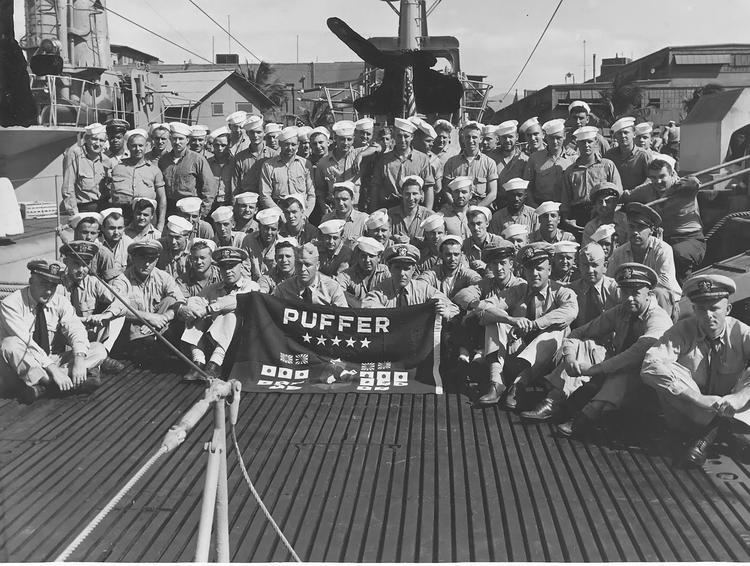Laid down 16 February 1942 Decommissioned 28 June 1946 Construction started 16 February 1942 Length 95 m | Commissioned 27 April 1943 Struck 1 July 1960 Launched 22 November 1942 | |
 | ||
Fate Sold for scrap, 3 December 1960 Builder | ||
USS Puffer (SS-268), a Gato-class submarine, was the first ship of the United States Navy to be named for the puffer, a fish which inflates its body with air.
Contents
- First and second war patrols September 1943 January 1944
- Third and fourth war patrols February June 1944
- Fifth war patrol July 1944 1944
- Sixth and seventh war patrols December 1944 1945
- Eighth and ninth war patrols May 1945 1945
- Post war service
- References
Puffer (SS-268) was laid down by the Manitowoc Shipbuilding Co., Manitowoc, Wisconsin, 16 February 1942; launched 21 November 1942; sponsored by Mrs. Ruth B. Lyons (granddaughter of the oldest employee at Manitowoc, Christ. Jacobson, Sr.); and commissioned 27 April 1943, Lt. Comdr. M. J. Jensen in command.

Puffer was transported down the Mississippi to New Orleans on a special floating drydock, having periscopes installed en route. After receiving torpedoes and ammunition, she exercised off Panama for a month, and then headed across the Pacific to Australia. Puffer arrived there in early September 1943.

First and second war patrols, September 1943 – January 1944

Her first war patrol, to intercept Japanese commerce in the Makassar Strait–Celebes Sea area, 7 September to 17 October, resulted in several damaged ships but no sinkings. On October 9, after damaging a merchantman, she endured a nearly 38-hour depth charging from 2 Japanese sub chasers and was slightly damaged. On 24 November Puffer sailed on her 2nd patrol, in the Sulu Sea and the approaches to Manila. On 13 December, she made a successful attack on freighter Teiko Maru (ex-Vichy French steamship D'Artagnan). On 20 December she sank 820-ton destroyer Fuyō, and on 1 January 1944, 6,707-ton freighter Ryuyo Maru, before putting in to Fremantle for refit 12 January.
Third and fourth war patrols, February – June 1944
Puffer departed for her 3rd war patrol, in the South China Sea, 4 February. On 22 February, she sank the 15,105-ton transport Teikyo Maru. Returning to Fremantle 4 April, she sailed again 30 April for Madoera Straits, Makassar Straits and the Sulu Sea. She acted as life guard for the first Allied carrier strike on Soerabaia, sank 3,181-ton freighter Shinryu Maru 18 May, then on 5 June, attacked three tankers, sinking 2,166-ton Ashizuri and 2,500-ton Takasaki. She ended this most successful patrol, for which she received the Navy Unit Commendation, at Fremantle 21 June.
Fifth war patrol, July 1944 – ~ 1944
On 14 July Puffer departed for her 5th war patrol, in Makassar Straits, the Celebes, Sulu, and South China Seas. She made contact with a submarine tender screened by five escorts on 21 July, spending three days following the group and using all but nine torpedoes to sink the tender.
Twenty three days later, on 12 August she made contact with a ten large vessels and their escorts. Five of the remaining nine torpedoes sank the 5,113-ton tanker Teikon Maru and a large freighter, with enough damage to beach another tanker. She completed the patrol at Pearl Harbor, whence she continued on to Mare Island for overhaul.
Sixth and seventh war patrols, December 1944 – ~ 1945
Following refresher training at Hawaii, Puffer got underway on her 6th war patrol 16 December. Operating in the Nansei Shoto area, she sank Coast Defense Vessel No. 42 on 10 January 1945; and, prior to her arrival at Guam, 17 January, damaged a destroyer, three freighters, and a tanker.
By 11 February, Puffer was underway again and following patrols in Luzon Straits and the South China Sea where she bombarded Pratas Island, she made an anti-shipping sweep of the Wake Island area.
Eighth and ninth war patrols, May 1945 – ~ 1945
Refitted at Midway she departed 20 May en route to the South China and Java Seas to conduct her 8th war patrol. In a surface sweep of the northern Bali coast, Puffer destroyed (by gunfire) two Japanese sea trucks and six landing craft on 5 July, and inflicted extensive damage to harbor installations at Chelukan Bawang and Buleleng, Bali. A brief respite at Fremantle followed, whence she headed north for her last war patrol, in the Java Sea.
Puffer earned 9 battle stars for World War II service in the Pacific Theater, with a total tonnage of 36,392 tons (eight ships).
Post-war service
Completing that patrol with the cessation of hostilities, Puffer headed for Subic Bay, thence to the United States, reaching San Francisco 15 October. With the new year, 1946, Puffer returned to Hawaii where she trained officers and men in submarine warfare until returning to San Francisco, 19 March, for inactivation.
Puffer decommissioned 28 June 1946, and was berthed at Mare Island as a unit of the Pacific Reserve Fleet. At the end of the year Puffer was ordered activated and assigned to the 13th Naval District for training Naval Reservists. Employed in that status, at Seattle, until relieved by Bowfin 10 June 1960, Puffer was placed out of service and sold for scrapping to the Zidell Corp., Portland, Oreg. 4 November 1960.
